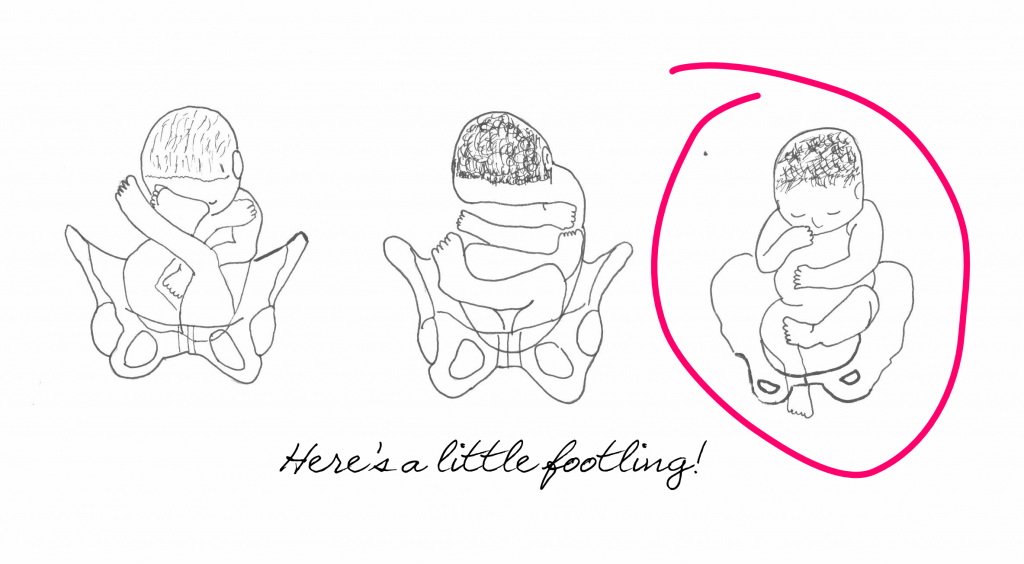
Babies in utero spend most of their gestation head-up. As they get heavier and prepare for delivery, they turn head-down. This usually happens around 32 weeks. When it doesn’t, and baby is still head-up at term, we call this baby breech.
When the baby’s head is up by the mother’s heart, the baby may be curled up in any number of positions—all of which are breech.
A footling breech baby is presenting feet or foot first. If we could look through the cervix, the first thing we’d see would be a foot. If labor started and the baby was pushed out this way, the first thing to emerge would be a foot.
A single footling has one knee drawn up so that only one foot is down and a double footling breech has both her feet together over the cervix.
Most breech babies come butt-first–Frank breech or complete breech. In this case, when the mother pushes her baby out, it’s a butt that is crowning, not a head (often called ‘rumping’).
Only about 20% of breech babies are footling breeches.
Footling breeches are trickier vaginal births. For one thing, there isn’t anything nice and solid and heavy pressing on the cervix to help it dilate. With a butt or a head over the cervix, it’s likely to dilate quicker and more efficiently.
Another risk of footling breech birth is cord prolapse. If the water is broken and a part of the umbilical cord falls through the cervix, it can create a dangerous situation for the baby due to cord compression and congealing.
Extremely rare in head-down birth, the incidence of cord prolapse rises considerably with breeches. Footling breeches have the highest risk (10-25%) because there is no butt or head blocking the cervix.
For many providers who are comfortable delivering a breech baby normally, footling breech position is a contraindication. For vaginal breech birth to be considered safe, a number of conditions must be met. The baby’s position is high on the list of questions.
Frank breech babies are generally seen as the safest because they can be delivered like a baby tube, neatly packaged with bum over cervix. These babies tend to do well in labor.
Part of the reason they do well is that the baby’s compacted body ‘opens the door’ for the head to pass through easily. With a footling, the baby’s feet can come down anytime and the birth canal may not be stretched as fully. Sometimes this makes birthing the head more difficult or dangerous.
Sometimes it does no such thing.
Check out some of the great footling breech birth stories and videos here.
Sometimes a footling will convert to a complete breech and come down butt-first once contractions begin. Keep this in mind when thinking about and discussing your options.
Finding a provider to attend and assist at your vaginal breech birth is already hard. Finding one who feels comfortable with a footling breech is even more difficult.
Some people do think it is easier to turn a footling. If you’re interested in ways to help a breech baby flip, it may just work. An ECV is safe and does reduce the likelihood a mother will end up with a cesarean.
Only you can make the decision, and I hope that if you feel comfortable with it you will convince your doctor to get some training or even consider traveling to avoid a cesarean.




